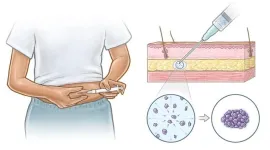Exploring why it is harder to hear in noisy environments
When people try to hear in environments with competing speakers, subcortical brain responses are increasingly smaller and delayed as more speakers come into play.
2025-03-24
(Press-News.org) Imagine trying to listen to a friend speak over the commotion of a loud party. It is difficult to detect and process sounds in noisy environments, especially for those with hearing loss. Previous research has typically focused on how competing sounds influence cortical brain activity, with the end goal of informing treatment strategies for people who are hard of hearing. But in a new eNeuro study, Melissa Polonenko and Ross Maddox, from the University of Rochester, explored a lesser-studied influence of competing sounds on subcortical brain activity. Because the subcortex processes sounds before the cortex does, shedding light on how sounds are processed in the subcortex has the potential to improve treatment strategies for and clinical assessments of those with hearing loss.
In their investigation, the researchers measured subcortical brain activity as participants processed simultaneous speech streams ranging from one to five talkers. Subcortical responses to speech concealed by simultaneous speech streams were increasingly smaller and delayed as more speech streams came into play. According to the authors, an important next step may be to determine whether people who struggle to hear in noisy environments undergo more significant subcortical changes than those who have an easier time hearing.
“This has implications for hearing loss, but also for those who do not have hearing loss and have extra challenges hearing when multiple people are talking at the same time,” says Polonenko.
###
Please contact media@sfn.org for the full-text PDF.
About eNeuro
eNeuro is an online, open-access journal published by the Society for Neuroscience. Established in 2014, eNeuro publishes a wide variety of content, including research articles, short reports, reviews, commentaries and opinions.
About The Society for Neuroscience
The Society for Neuroscience is the world's largest organization of scientists and physicians devoted to understanding the brain and nervous system. The nonprofit organization, founded in 1969, now has nearly 35,000 members in more than 95 countries.
END
ELSE PRESS RELEASES FROM THIS DATE:
2025-03-24
The high comorbidity of type 2 diabetes (T2D) with psychiatric or neurodegenerative disorders points to a need for understanding what links these diseases. A potential link is the anterior cingulate cortex (ACC). The ACC supports behaviors related to cognition and emotions and is involved in some T2D-associated diseases, like mood disorders and Alzheimer’s disease (AD). James Hyman and colleagues, from the University of Nevada, Las Vegas, used a rat model of T2D that affects only males to explore whether diabetes affects ACC activity and behavior. Their work is featured in JNeurosci’s ...
2025-03-24
Embargoed for release: Monday, March 24, 12:00 PM ET
Key points:
Maintaining a healthy diet rich in plant-based foods, with low to moderate intake of healthy animal-based foods and lower intake of ultra-processed foods, was linked to a higher likelihood of healthy aging—defined as reaching age 70 free of major chronic diseases, with cognitive, physical, and mental health maintained—according to a 30-year study of food habits among more than 105,000 middle-aged adults.
All the eight dietary patterns studied were associated with healthy aging, suggesting that there is no one-size-fits-all healthy diet.
The study is among the ...
2025-03-24
Mass General Brigham and MIT investigators have developed a long-acting contraceptive implant that can be delivered through tiny needles to minimize patient discomfort and increase the likelihood of medication use.
Their findings in preclinical models provide the technological basis to develop self-administrable contraceptive shots that could mimic the long-term drug release of surgically implanted devices.
The new approach, which would reduce how often patients need to inject themselves and prove valuable for patients with less access to hospitals and other medical care ...
2025-03-24
Motion sickness is a very common condition that affects about 1 in 3 people, but the brain circuits involved are largely unknown. In the current study published in Nature Metabolism, researchers at Baylor College of Medicine, the University of Texas Health Science Center at Houston and the Jan and Dan Duncan Neurological Research Institute at Texas Children’s Hospital describe a new brain circuit involved in motion sickness that also contributes to regulating body temperature and metabolic balance. The findings may provide unconventional strategies ...
2025-03-24
MEDIA INQUIRES
WRITTEN BY
Laura Muntean
Adam Russell
laura.muntean@ag.tamu.edu
601-248-1891
FOR ...
2025-03-24
About The Study: This study found a disproportionate spike in firearm homicide among children and adults older than age 30 after the onset of the COVID-19 pandemic, indicating a change in the association between age and firearm victimization risk. This trend moved the peak victimization risk from age 21 to 19, and rates for children up to age 16 were markedly elevated. These age-specific patterns were most pronounced in later post-onset years.
Corresponding Author: To contact the corresponding author, Jonathan ...
2025-03-24
About The Study: This study found that avoidable mortality (comprising both preventable deaths related to prevention and public health and treatable deaths related to timely and effective health care treatment) has worsened across all U.S. states, while other high-income countries show improvement. The results suggest poorer mortality is driven by broad factors across the entirety of the U.S. While other countries appear to make gains in health with increases in health care spending, such an association does not exist across U.S. states, raising questions regarding U.S. health spending efficiency.
Corresponding Author: To contact the corresponding author, Irene ...
2025-03-24
About The Study: Exclusive or longer duration of breastfeeding was associated with reduced odds of developmental delays and language or social neurodevelopmental conditions in this cohort study. These findings may guide parents, caregivers, and public health initiatives in promoting early child development.
Corresponding Author: To contact the corresponding author, Inbal Goldshtein, PhD, email inbal@kinstitute.org.il.
To access the embargoed study: Visit our For The Media website at this link https://media.jamanetwork.com/
(doi:10.1001/jamanetworkopen.2025.1540)
Editor’s Note: Please see the ...
2025-03-24
Among the many marvels of life is the cell’s ability to divide and thus enable organisms to grow and renew themselves. For this, the cell must duplicate its DNA – its genome – and segregate it equally into two new daughter cells. To prepare the 46 chromosomes of a human cell for transport to the daughter cells during cell division, each chromosome forms a compact X-shaped structure with two rod-like copies. How the cell achieves this feat remains largely unknown.
Now, for the first time, EMBL scientists have directly observed this process in high resolution under the microscope ...
2025-03-24
After every meal, the intestines perform an action called peristalsis — moving food through their hollow interiors with coordinated contractions and relaxations of the smooth muscle.
For more than a century, scientists have known that nerve cells in the gut propel the colon to move, allowing the organ to perform its life-sustaining function. But exactly how these intestinal nerve cells do their job has remained elusive.
Now a new NIH-funded study led by researchers at Harvard Medical School and the Icahn School of Medicine at Mount Sinai has identified ...
LAST 30 PRESS RELEASES:
[Press-News.org] Exploring why it is harder to hear in noisy environments
When people try to hear in environments with competing speakers, subcortical brain responses are increasingly smaller and delayed as more speakers come into play.

